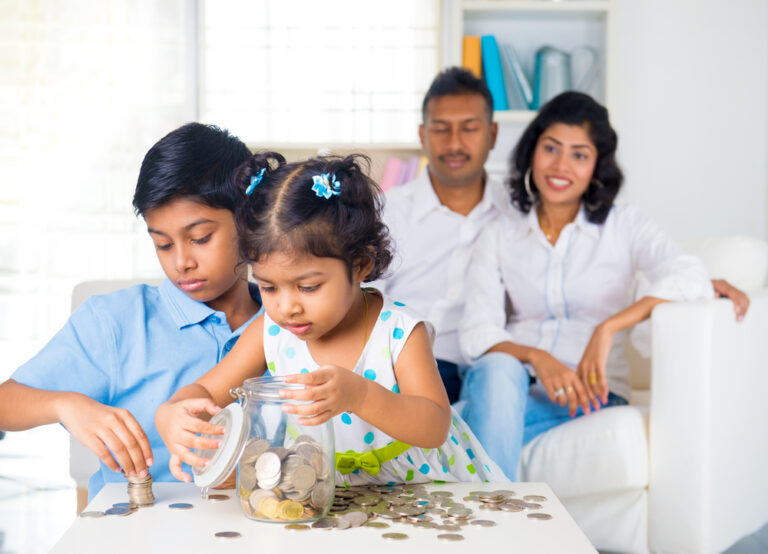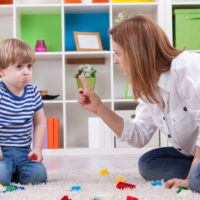When children are young, they don’t necessarily understand that everyone makes mistakes (even adults). Even when they understand the rules, however, it’s easy to shift blame to someone else. Below, we’ll take a look at how to teach a child to take responsibility for their actions and why it’s important.
Help Your Child Understand Cause and Effect
Consequences are a type of cause and effect. It can be helpful to speak of them using “if, then” statements. For example, if your child jumps in a puddle on the way to the birthday party, then they are going to have wet shoes through the celebration. If your child doesn’t do their chores, then they may not get to watch an extra movie before bed or have another consequence.
It’s important to also show your child that consequences aren’t always negative outcomes. For example, you might take them out for ice cream because they got an ‘A’ on their math test or they might talk to a new kid at school and make a friend as a result. Help your child connect the dots in these real-life scenarios, so it’s easier for them to understand the impact that their decision has on their life.
RELATED: How to Unspoil a Child in a Loving Matter
Talk About Why Mistakes Are Important
Mistakes are often painted as something bad when they should be looked at as an opportunity to learn. When your child is taught to learn from his or her mistakes, they’re more likely to be honest about them in the future. This is especially true if you sit and talk to them about how to handle them, rather than punishing them. Be sure to express that while making mistakes is important, they shouldn’t be repeated when there are better choices that can be made in the future.
RELATED: How to Discipline a 1-Year-Old
Use “We” to Address Expectations
When you talk to your child about expectations in the home, it’s important that you use the word “we” rather than “you”. For example, instead of saying “you didn’t put your dishes in the sink after eating,” encourage your child to pick up and say that “we put our dishes in the sink after eating.” Using we instead of you reassures your child that they have to follow the same expectations as the rest of the family unit. Additionally, it doesn’t put blame on them- just encourages them to take responsibility for cleaning up their dishes in the future.
Don’t Over-React to Honesty
A big part of taking responsibility is being honest about a person’s actions. It’s important that when your child is truthful, they are encouraged to continue being honest in the future. Instead of getting upset, be calm and composed. Be sure to maintain an open channel of communication and encourage your child to come forward when they have done something wrong.
When your child does talk to you, remind him or her that everyone makes mistakes. It is more important to focus on being honest and trying to do better the next time the situation arises. After reminding your child of this, talk about what they could do differently next time. You could also discuss any consequences if you think they are necessary.
Model Taking Responsibility
Children learn a lot from everything that happens around them. It’s important for parents, older siblings, relatives, and other caregivers to show their children how to take responsibility, too.
For example, imagine that you burnt the toast in the morning. Instead of blaming it on the toaster or the oven, it’d be better to say, “Oops, I burnt the toast! That’s okay, though. Accidents happen and we can make some more to fix it.” It’s important that your children see adults are humans capable of making mistakes, too.
RELATED: How to Get Your Kid to Clean Their Room
Use a Chart
Using a chart to keep track of decision-making helps children who are more visual. In my house, our children have a chore chart that has a list of their daily responsibilities. This includes things like taking their dishes to the sink and picking up their dirty laundry off the floor. We do an allowance of $10 per week. Each time that they make a decision not to do what is expected of them, 25 cents is deducted from their money at the end of the week.
If your children don’t earn an allowance, you could use a similar technique with a different reward. For example, if your child goes all week without getting five negative marks, they might get to go to the park or pick a movie for family movie night.
RELATED: Here are Chores Your Kids Can Actually Do – by Age
Teach Problem Solving
Teaching your child to solve problems young helps them be solution-oriented with consequences. The best way to teach problem-solving is by talking through problems with your child. By working on real-world situations, they learn what they can do differently in the future.
For example, imagine that your child scored low on a test. If your child places blame, they might say they didn’t understand the teacher. Even though it is your child’s teachers job to make sure they learn, however, your child’s teacher isn’t at fault if your child doesn’t ask for extra help. The next time, he or she could ask their teacher, a parent, an older sibling, or even a friend that understands a little bit more to help them understand it.
Address Emotions
Something else that should be addressed when taking responsibility is emotions. As a mother of two boys, I can definitely say there are days my boys’ emotions get the better of them. One of them will snatch a toy and before anyone has blinked the other one has hit him in retaliation. This seems like a split-second reaction because of the surge of emotions behind it, but it’s still important to take responsibility in a situation like this.
If your child struggles with emotion, talk to him or her about what they are feeling. Talk about what it feels like and give the emotion a name. If your child frequently lashes out because of anger, sadness, or another emotion, talk to him or her about better ways to handle it in the future. Remind your child that even when they react to how someone makes them feel, they are still responsible for their actions.
Something else that helps with emotions is taking a deep breath. Emotions may cause a quick reaction with little time to think. Instead, teach your child to take a breath and address the situation. If someone else is involved, they can walk away, ask for help, or use their words to stand up for themselves.
RELATED: How to Get Kids to Listen: 7 Helpful Tips
FAQs – How to Teach a Child to Take Responsibility for Their Actions
What does it mean to take responsibility for your actions?
Taking responsibility for your actions means accepting that you have a pivotal role in your own life. It means being accountable for both the good and bad things in your life. This includes both the positives and the consequences. Taking responsibility means not shifting blame to others. Even when there are parts of a situation out of our control, we are responsible for how we respond to it and what we do.
Why is it important to take responsibility?
Being responsible for your actions is important because it creates accountability. Accountability is a willingness to accept the consequences (good and bad) of the things we do and say. This is important because the actions of individuals can and do affect others. Individuals are part of their family unit, as well as groups in the world like school, the workplace, and society as a whole.
When accepting a consequence, it also allows us the chance to see where we are flawed. This leaves room for future improvement.
What is the difference between an explanation and an excuse?
When teaching your child to take responsibility for his or her actions, it’s also important that they understand the difference between an explanation and an excuse. When you explain why something happened, you are taking accountability for what happened. Making an excuse places the blame elsewhere, avoiding taking responsibility for what happened.
For example, imagine that your child was late for school. An explanation might be that they took too long getting dressed and they could tell their teacher they would pay more attention to the clock in the future. If your child made an excuse, however, they might place the blame on their parent because they were driving- even if your child was the one late getting to the car.
Final Word
Parents considering how to teach a child to take responsibility for their actions are taking an important step in teaching their child to be part of the bigger picture. This helps grow into responsible adults that meet the expectations of the world they live in. Hopefully, this article has given you some ideas on how you can do just that.






